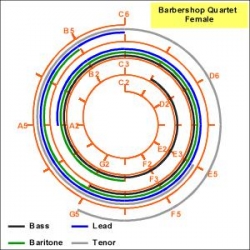Add a comment
On Range and Tessitura
‹-- PreviousNext --›
At the most basic level, range is the primary criterion for deciding on an arrangement’s suitability for a particular ensemble. If the person singing that part doesn’t have notes used at either top or bottom, there’s no point attempting the song, as it will always over-stretch the group – and at key musical points, too. (Extremes of high and low notes never appear casually or en passant.)
But range doesn’t tell you everything you need to know about how a song lies on the voices.
You also want to know whether the part generally hangs out in the upper or lower part of that range: that is, its tessitura. At the moment, and for the foreseeable future, the only way you can find that out is to ask me for an inspection copy. But I am rather fascinated with the idea of metrics to measure tessitura. I have worked out, conceptually, how this could work, but have not the faintest idea how to do it in practice.
So, just as there three different types of average, there are three ways to articulate a part’s mid-point. The first – the equivalent of the mean – is simply the half-way point between the highest and lowest notes in the range. This is easy to find, but gives you no more information than the range.
The second is the mode average – the note that appears most frequently. This is useful to know because you want to be picking songs that don’t, for instance, sit on a break. Obviously, we all put a lot of attention into smoothing out our passaggi and making sure they don’t interrupt the musical flow of what we sing, but you don’t want to be putting extra pressure on it if the technical control is still a work-in-progress.
The third kind of mid-point is the weighted median. If you re-ordered all the notes in a part so that each appeared in ascending order, but for the correct duration, and took out all the rests, the note that comes at the mid-point in time is your measure of tessitura. My guess is that it would often be close or identical to the mode note, but that these could often be noticeably higher or lower than the straight mean. For instance, the tenor part of ‘Let’s Face the Music’ goes (in the women’s key) from B3 to G#5, giving a mid-point of A/A#4. But the low B is introduced at a very late stage in a series of unison gestures, and the part as a whole doesn’t spend very much time at all in the bottom 4th of the range – so my guess is that the weighted median would be a bit higher than the mean.
As I say, I have no idea how to generate these modes or weighted medians, which is a pity as they could provide some really interesting data about the lie of a part on the voice. Indeed, I rather like the idea of discovering whether different arrangers have typical tessitura/range thumbprints, and how these metrics correlate with things like singer enthusiasm and audience response.
In the meantime, I am finding some interesting patterns in the ranges. For instance, a part will often open out a certain pitch space during the first quarter of an arrangement, and then stay within it for most of the rest, before making a significant stretch higher (and/or occasionally lower) towards the end. And the long-range chromatic voice-leading within each part almost always fulfils its implications. So, if two-thirds of the way through a song in A major, the baritone’s highest note is A#, the B above (its implied resolution point) is pretty much guaranteed to appear somewhere before the song finishes.
Most usefully for people picking songs to sing: there is a pretty strong correlation between size of the range required and the musical difficulty of the arrangement. This is often a function of the song itself: songs with rangy melodies are also often more harmonically ambitious than songs that proceed by step within a small ambit. But it’s also a function of the groups they were written for: there’s a strong correlation between vocal confidence right to the edges of the range and musical confidence to take on harmonic and/or rhythmic challenges.
But adding up the total ranges of all four parts – or maybe taking the mean average, since there are some arrangements with more than 4 parts – gives a pretty good rough-and-ready difficulty rating. It may need inflecting with information about length for a more accurate measure – but actually, there’s a pretty good correlation already between range and length. (After all, it’s the longer forms that are more likely to need the kind of dramatic gesture that increase the size of the range required.)
If anyone has any ideas about how to generate the kinds of pitch analyses I’m getting interested in from music files (Capella and/or Sibelius), do drop me a hint!












